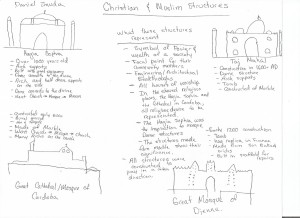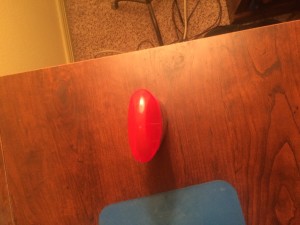I decided to look at the religious structures. More specifically, I just looked at the religious structures mainly from the religions of Christianity and Islam. I analyzed the reading from class, watched the videos on the structures, and did additional research. On my concept map, I have each individual structure; Hagia Sophia, Great Cathedral of Cordoba, Taj Mahal, Great Mosque of Djenne. Under the structures I have some basic facts about them, when they were constructed, what they were made out of, what religion they were apart of, and the structure that they were made from. In the middle of my concept map, I have what these structures represent for their society. For each of the structures I analyzed, they represented and continue to represent wealth and power of their society. Some of these structures have been conquered by opposing religions because of their significance. I learned the Hagia Sophia was an inspiration to the Dome style of mosques, I also learned that the way that the buildings were designed was so that everyone could pray facing the same way. The architecture for the Hagia Sophia was a dome that came down on a square, it was an incredibly difficult structure to engineer. The Taj Mahal was built nearly the same way as the Hagia Sophia was. Many of these structures were built from marble, which signifies how important these structures were to the community.
Competing interpretations of the first Thanksgiving
Part 1.
I personally feel that the first reading, “The Pilgrims and America’s First Thanksgiving” accurately represents how I was originally taught about thanksgiving in elementary school. We were taught that everything that happened between the two different groups were peaceful and that the Indians and the white men shared among each other. “First Thanksgiving” has the closest resemblance to how think of what Thanksgiving is. My parents explained to me, long before school ever did, that the way we were taught about Thanksgiving doesn’t mean it’s the truth. They also taught me though was that the peace didn’t last very long and soon after it became an incredibly down hill slippery slope for the Native Americans and it cost them their land and lives. In school they teach it a lot more happy and that everything was fine between both groups of people, though that wasn’t the case. My understanding of Thanksgiving has changed because the public education system sometimes feeds the masses corrupt information that doesn’t necessarily include the whole truth. I think about the age of thirteen I realized that a lot of what I’m being taught in school has another side of the story, not just what I’m being told.
Part 2.
I do think that the different approaches to Thanksgiving are a little intriguing. I could tell from some of the “part 1” articles that some people might focus on the idea that everyone was lazy and didn’t want to work. I’m not saying that isn’t how it went, I’m just saying that people like to focus on what they want to see rather than what might have caused that to happen. I don’t find any of them that make a compelling case enough for me to change my opinions on Thanksgiving all together. Everything has a bias, and it’s really hard to find a reliable source that doesn’t have a hand in it, no matter if it’s a conscious decision or not. I think Rush Limbaugh is an idiot, who right along side trump, should close their mouths for the sake of the Republican party. I have not read the books he did, so I can’t argue with his statements in his article, but I personally do have the belief that Native Americans have been constantly taken advantage of and run out of their land. I do not believe that they have been given a fair shake, as he claims. I don’t think that even knowing who the authors were influenced how I viewed the articles, I think that since it’s easy to see the author’s voice in the articles they write, it’s fairly easy to make a judgement on who they are. I think once you are able to see the biased in an article it already makes it unreliable, even if it’s the truth.
Part 3.
I do find these articles much more interesting than in part 2. I think that they offer many different views, not just the economic stand point, or the views that a lot of my peers have. When a party presents different information it’s a lot more interesting. I think that looking at it from a teacher’s perspective, or a Native American, or even a historian adds something to the discussion. It isn’t just focused on one sides belief system and debating that over and over. I do find them compelling, but I don’t think any one in particular changed my mind. I think that every article brings something else to the table, I can agree the most with the teacher. My Grandpa is from a reservation, and he’s told me stories about how rough it was growing up coming from a place of nothing. I’ve heard countless stories, and it amazes me that the general public doesn’t recognize the atrocities that have occurred prior, and are continuing to occur. One of the authors is obviously a teacher, I couldn’t find his name. Another author is a Native American who passed here recently, who basically was a scholar on when the English came to America. The New York times article was written by a conservative hating journalist. I do not think knowing any of these authors influences how their piece reach their audience. I think that since we were able to read them first, and evaluate what is included, it has helped us take a step away from the authors.
Part 4.
I think a historian would make sense of the “First Thanksgiving” by not adding any opinion to their conclusion. I think that in order to come to a logical conclusion they must be passionate about the work that they are doing and dive completely into their work. I think that the steps that need to be taken in order to find the answer would to look at everyone’s viewpoint and maybe write about it from different perspectives. I don’t think there is ever going to be a point where we agree that the people who came to America were horrible and doing the wrong thing, nor were the Native Americans. I think that the truth has many different meanings, and especially for different people. I think that the whole idea behind Thanksgiving needs to be evaluated, and we need to maybe focus less on doing things because it’s “Tradition” and more because it’s right or not. I think that a person 18-30 should be mature enough to have open discussions with their friends, family, loved ones, people on the internet. I don’t think they need to come to a conclusion, but I do think that they at least need to acknowledge the different information and the different places it’s coming from in the articles. I think people determine what is most compelling by what they don’t know. If something has just been introduced to them, and it makes them look at a situation in a whole different light, I think that’s how most people determine if it’s most compelling. I think the first place I would look for a reliable source would probably be in the BSU Library database, and I would do the CRAAP test to determine if it was worthy of me looking at it or not.
Prownian Analysis
Step 1: The object is four different colors, red, grey, and has white and blue text written on it. The object is round at it’s edges, and has a rounded lid that can be put on or off. It is made out of plastic. There is a piece of plastic at the base of the object that can be twisted, which in turn, pushes different wax like material out of the top. The wax like material is a green blue and has a fresh scent to it.
Step 2: Since the object is used out of hard plastic on the outside, but is surrounding a wax like substance. I can assume that this is a container of some sort is used to protect the wax like substance. I can only assume that the wax is used in order to hold in or back liquid or some other form of substance. The way that the container and wax is shaped it looks like it is used to fit into your hand, and can be applied to natural curves of the body. The object is made out of plastic, so it could possibly last a long time. The wax on the other hand, if not covered by it’s cap, could dry out.
Step 3: I would assume that this object is used by males because on the warning label it says “For a man who knows…”. We can speculate that the bright red is used in stores in order to gain people’s attention and to stand out. This product is used to stop sweating, and the smell that sweating causes. Since it is “Pure Sport” is can be implied that the people using the object are doing something physically active and will expect to be sweating.
Questions about the Object:
How long does this object last?
How many different scents of Old Spice are there?
What are the adverse effects of using this object?
Bibliography
A. Andrew. “Old Spice ‘pure Sport’ deodorant”. Last modified December 15, 2013. http://labelsdeclassified.com/2013/12/15/old-spice-long-lasting-stick-pure-sport-deodorant/.
The author finds that the deodorant is harmful and needs to be reexamined. He doesn’t understand why people are buying a product that is hurting them in the end, and why people are allowed to sell such things to the general public. He explains in the article the many different chemicals in deodorant, and how they effect us long term. The way this author looked at the object, was that he focused on just the label and how that effects him as an individual and us as a society. He focuses less on how the object appears to be represented through its physical attributes. He makes a lot more speculation about how much this is going to cause damage to everyone in the near future.
Boon, Nico. Callewaert, Chris. Hutapea, Prawira. Van de Weilde, Tom. “Deodorants and antiperspirants affect the axillary bacterial community”. July 31, 2014.
In this article it talks about the use of deodorant, and how it can cause more odor on our bodies than if we weren’t using it. They say that it causes the bacteria on our bodies to change and produce a much stronger sense of smell, only when using the deodorant. These authors looked at not the physical aspect of the deodorant, but how the chemicals used change the world around us, and on our bodies. They took notice of much smaller things and how it was going to effect us in the future.


